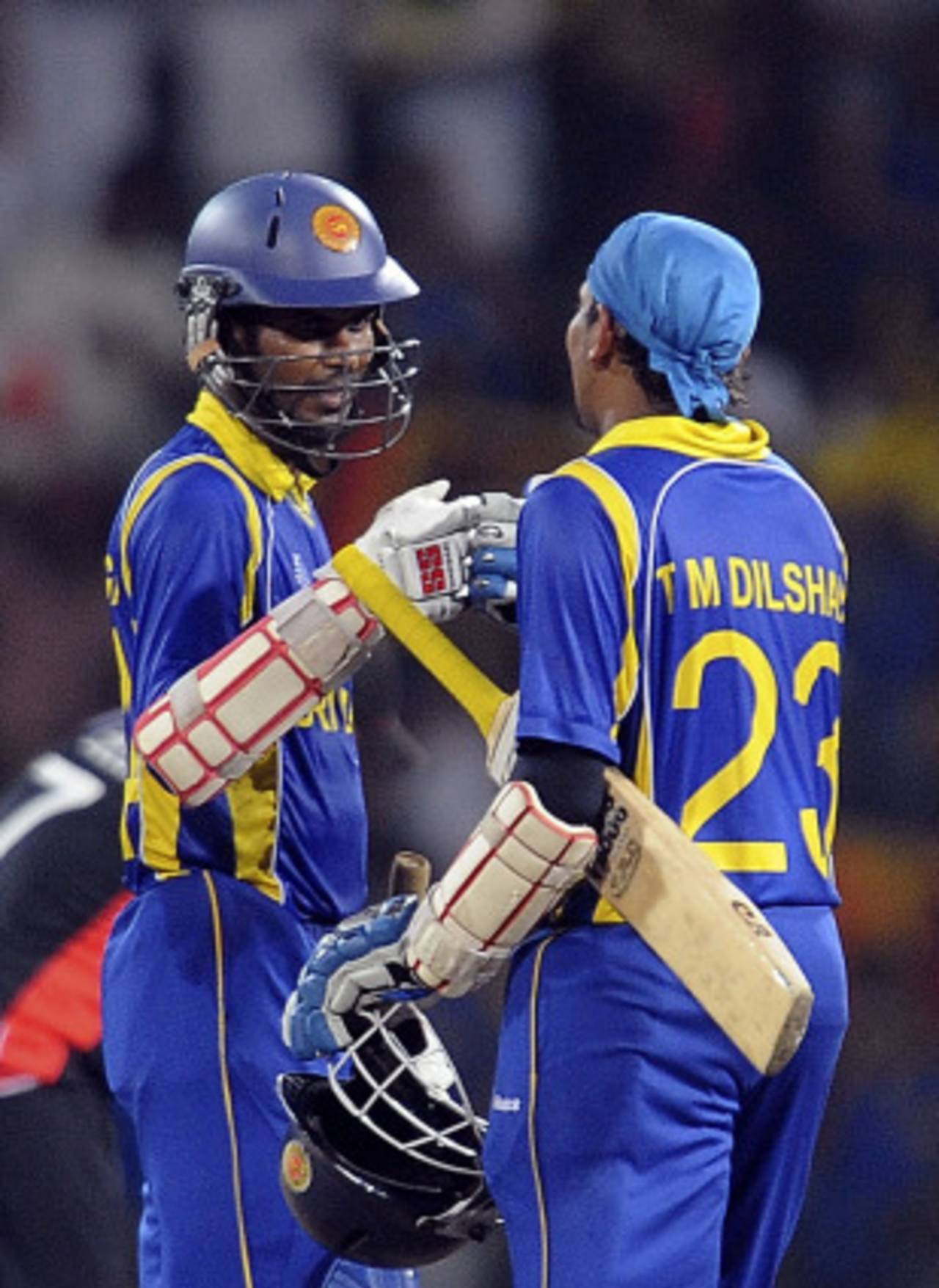Sri Lanka put Premadasa chasing fears to rest
The last time 230 was chased at the Premadasa was six-and-a-half years ago. It was fitting then that on the big day the home side lost the toss, and put in a supreme performance to comfortably chase and win
Sidharth Monga at the Premadasa
26-Mar-2011

Dilshan and Tharanga: The third-most prolific opening combination for Sri Lanka • Getty Images
Today the R Premadasa Stadium became only the fourth ground to have hosted 100 ODIs. Yet it is a much-maligned venue, and not without reason either. It was actually a surprise that they kept playing ODIs under lights here, with the side batting first at an obvious and a significant advantage, what with the evening moisture and the ordinary floodlights deciding most of the games between evenly matched sides at the toss. The last time 230 was chased here was six-and-a-half years ago, a statistic that speaks for itself.
However, for the year and a half running into the World Cup, they stopped playing here. As they renovated the stands, they also tried to figure out what they could do to address that imbalance. They realised that because the ground is in a low-lying area, the moisture comes up in the evenings and assists seam movement. So they raised the square by three-and-a-half feet, and also installed new, improved floodlights. Hosting a World Cup is a matter of prestige, and nobody would have wanted two unfair knockout matches in Sri Lanka.
It was natural that the statistics were thrown around in the lead-up to the match. "Toss crucial," ran the headlines around the world. Meanwhile Sri Lankan players told anybody who would listen that things had changed, a glimpse of which was shown in how they had looked comfortable chasing 278 against Pakistan before losing their way. It was fitting then that on the big day the home side lost the toss, and put in a supreme performance to not only chase and win, but chase and win comfortably at that.
Of course they didn't win because batting second was easy. Batting was still a bit difficult; 230 was still a good target on a low and slow pitch, in a high-pressure World Cup knockout game. And they didn't win because they just batted well; their bowling was superb for the conditions, never mind the three dropped catches. More importantly, for all of England's tenacity - and they were tenacious even today for 70 overs - Sri Lanka had enough class to fall back upon and pull the opposition back. Don't forget that Muttiah Muralitharan was one of the most expensive bowlers on either side, and yet - except during the partnership between Jonathan Trott and Eoin Morgan - Sri Lanka never really looked in trouble.
Shrewdly they opened the bowling with Tillakaratne Dilshan, knowing England would be circumspect with their third different opening combination of the tournament. Dilshan, a smart cricketer, gave the openers little pace to work with, and by the time he was taken off, England had the uninviting prospect of facing 30 overs of specialist spin out of the 42 remaining. England played Muralitharan well, getting to the pitch of the balls and dabbing, paddling, reverse-paddling him for ones and twos. Then came a period when the game seemed to be running out of Sri Lanka's butter fingers. Three catches went down, a chance to challenge a not-out lbw call was missed, and England looked good to get even 260, which would have seriously challenged Sri Lanka, evening or no evening.
England called for the batting Powerplay at 182 for 3 after 42 overs, with set batsmen in the middle who had added 87 in 15 overs. Kumar Sangakkara called for Lasith Malinga. Malinga needed one loosener before firing in three yorkers followed by a slower ball that accounted for Morgan. The fielders woke up again, with Dilshan and Chamara Silva not allowing twos in the outfield and Malinga and Ajantha Mendis not allowing boundaries. Andrew Strauss admitted later that they were not allowed to play well by "a very good side".
Putting Dilshan and Upul Tharanga together at the top of the order has been Sri Lanka's biggest ODI investment over the last two years. Dilshan had been a middle-order batsman, and to persist with Tharanga, the team management has had to fight undue outside pressures to bring Sanath Jayasuriya back. Both were bold moves, and both have paid off: in 32 attempts the two have added 2023 at an average of 65.25, incidentally surpassing tonight the Jayasuriya-Tharanga combine to become the third-most prolific opening combination for Sri Lanka.
It was evident why they work so well together. When Dilshan struggled for timing in the first half hour, it was Tharanga who took the initiative and cut Tim Bresnan and lofted Graeme Swann. There was a clear understanding that Dilshan could throw things away if the runs didn't come fast enough, and that's where Tharanga came in. Once Dilshan got in, he took charge of the scoring, and in synchronicity they moved towards their centuries.
The freedom with which they batted proved two things. The Sri Lankan bowlers were much higher in quality, and the conditions weren't as tough as it seemed when England batted. There was the aggressive intent that is necessary to score runs on these pitches, something neither England's technique nor their loss of wickets allowed them to do.
Not long into the Sri Lankan innings, the stands turned into a party. The steel bands blared in every stand, the people danced, exaggerated defensive shots from Dilshan ensured there were enough runs left for Tharanga to get to his century too. Amid all that, a ground was possibly sent on redemption path too.
Sidharth Monga is an assistant editor at ESPNcricinfo